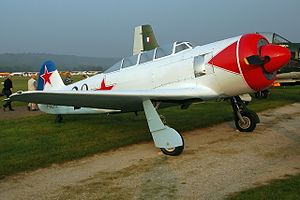| Yak-11 | |
|---|---|
| Role | Training aircraft |
| Manufacturer | Yakovlev, Let |
| First flight | 10 November 1945 |
| Introduction | 1946 |
| Retired | 1962 |
| Primary user | Soviet Air Force |
| Number built | 4,566 |
The Yakovlev Yak-11 (NATO reporting name: "Moose", Russian: Як-11) was a trainer aircraft used by the Soviet Air Force and other Soviet-influenced air forces from 1947 until 1962.
History[]
The Yakovlev design bureau began work on an advanced trainer based on the successful Yak-3 fighter in mid 1944, although the trainer was of low priority owing to the ongoing Second World War.[1] The first prototype of the new trainer, designated Yak-UTI or Yak-3UTI flew in late 1945. It was based on the radial-powered Yak-3U, but with the new Shvetsov ASh-21 seven-cylinder radial replacing the ASh-82 of the Yak-3U.[2][nb 1] It used the same all-metal wings as the Yak-3U, with a fuselage of mixed metal and wood construction. Pilot and observer sat in tandem under a long canopy with separate sliding hoods. A single synchronised UBS 12.7 mm machine gun and wing racks for two 100 kg (220 lb) bombs comprised the aircraft's armament.[3]
An improved prototype flew in 1946, with revised cockpits and a modified engine installation with the engine mounted on shock absorbing mounts.[2] This aircraft successfully passed state testing in October 1946, with production beginning at factories in Saratov and Leningrad in 1947.[4]
Production Yak-11s were heavier than the prototypes, with later batches fitted with non-retractable tail wheels and revised propellers. A 7.62 mm ShKAS machine gun was sometimes fitted instead of the UBS, while some were fitted with rear-view periscopes above the windscreen.[4] In total, Soviet production amounted to 3,859 aircraft between 1947 and 1955. with a further 707 licence-built by Let in Czechoslovakia as the C-11.[5]
The Yak-11 set five world-class records.
Yak-11U[]
In 1951, Yakovlev revised the design of the Yak-11, adding a retractable tricycle landing gear, with two variants proposed, the Yak-11U basic trainer and Yak-11T proficiency trainer, which carried similar equipment to contemporary jet fighters. The new aircraft had reduced fuel capacity and was unsuitable for operations on rough or snow covered runways, and so was rejected for Soviet service, although a few examples were built in Czechoslovakia as the C-11U.[6]
Operational history[]
The Yak-11 entered service in 1947, serving as a standard advanced trainer with the Soviet Air Forces and DOSAAF.[7] Both Yak-11 and C-11 were used in all Warsaw Pact countries and were exported to eighteen countries, including many African, Middle Eastern and Asian countries.[4]
North Korean Yak-11s were used in combat in the Korean War, with one Yak-11 being the first North Korean aircraft shot down by US forces when it was shot down by a North American F-82 Twin Mustang over Kimpo Airfield on 27 June 1950.[8] East Germany used the Yak-11 to intercept American reconnaissance balloons.[7]
Survivors[]
Due to its Yak-3 lineage, the Yak-11 has recently seen widespread popularity among warbird enthusiasts. Souped-up versions of the Yak-11 can be frequently seen at air races. About 120 Yak-11s remain in airworthy condition.
Operators[]

Yak-11 operators

Czechoslovakian Yak-11

Fighter trainer aircraft Yakovlev Yak-11 (National People's Army)

Preserved Yak-11 of Polish Air Force

Yakovlev Yak-11 disguised in a wartime fighter camouflage
 Afghanistan
Afghanistan
- Royal Afghan Air Force received 14 aircraft from 1958. None remain in service since 1999.
- Albanian Air Force received four aircraft.
- Polish Air Force used 101 Soviet Yak-11s and 37 Czech-built C-11s
Description[]
Mixed construction (metal and wood) trainer plane. 7-cylinder radial engine with two-blade fixed propeller. Conventional retractable landing gear with fixed tailwheel.
Specifications (Yak-11)[]
General characteristics
- Crew: Two - student and instructor
- Length: 8.20 m (26 ft 10½ in)
- Wingspan: 9.4 m (30 ft 10 in)
- Height: 3.28 m (10 ft 5 in)
- Wing area: 15.40 m² (166 ft²)
- Empty weight: 1,900 kg (4,189 lb)
- Loaded weight: kg (lb)
- Max. takeoff weight: 2,440 kg (5,379 lb)
- Powerplant: 1 × Shvetsov ASh-21 air-cooled radial piston engine, 521 kW (700 hp)
Performance
- Maximum speed: 460 km/h (289 mph)
- Cruise speed: 370 km/h (230 mph)
- Range: 1250 km (795 miles)
- Service ceiling: 7,100 m (23,295 ft)
- Rate of climb: 8.1 m/s (1,600 ft/min)
- Wing loading: 161 kg/m² (32.9 lb/ft²)
- Power/mass: 0.17 kW/kg (0.10 hp/lb)
Armament
See also[]
| Wikimedia Commons has media related to Yakovlev Yak-11. |
Notes[]
Citations[]
- ↑ 1.0 1.1 Gunston 1995, p. 469.
- ↑ 2.0 2.1 Gordon Komissarov and Komissarov 2005, p. 249.
- ↑ Gunston and Gordon 1997, p. 97.
- ↑ 4.0 4.1 4.2 Gunston and Gordon 1997, p. 99.
- ↑ Gordon Komissarov and Komissarov 2005, pp. 250–251.
- ↑ Gordon Komissarov and Komissarov 2005, p. 251.
- ↑ 7.0 7.1 Gordon Komissarov and Komissarov 2005, p. 250.
- ↑ Thompson 2001, pp. 160–161.
References[]
- Gordon, Yefim, Dmitry Komissarov and Sergey Komissarov. OKB Yakovlev: A History of the Design Bureau and its Aircraft. Hinkley, UK: Midland Publishing, 2005. ISBN 1-85780-203-9.
- Gunston, Bill. The Osprey Encyclopedia of Russian Aircraft 1975–1995. London, UK: Osprey, 1995. ISBN 1-85532-405-9.
- Gunston, Bill and Yefim Gordon. Yakovlev Aircraft since 1924. London, UK: Putnam Aeronautical Books, 1997. ISBN 1-55750-978-6.
- Thompson, Warren. "Twin Mustang in Korea". International Air Power Review. Volume 3, Winter 2001/2002. Norwalk, Connecticut, USA:AIRtime Publishing. ISBN 1-880588-36-6. ISSN 1473-9917. pp. 156–167.
The original article can be found at Yakovlev Yak-11 and the edit history here.

